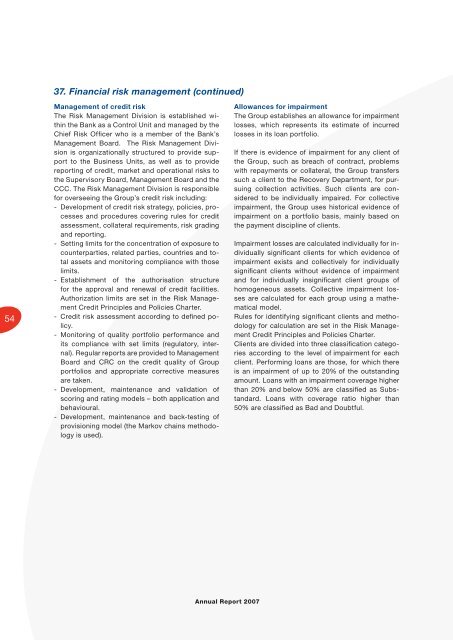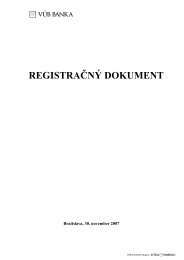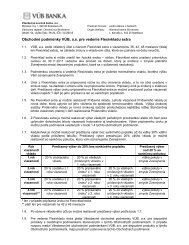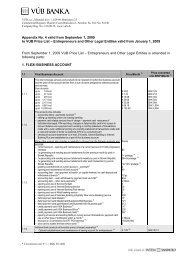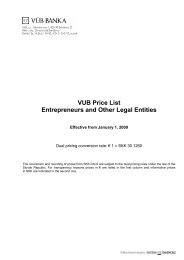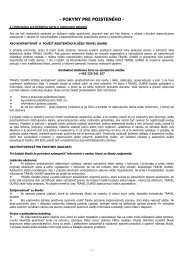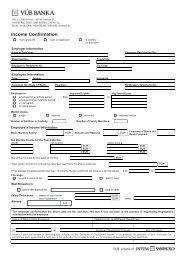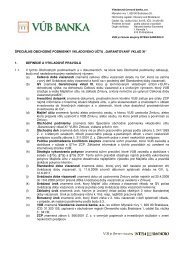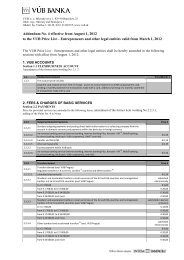Annual Report - VÃB banka
Annual Report - VÃB banka
Annual Report - VÃB banka
You also want an ePaper? Increase the reach of your titles
YUMPU automatically turns print PDFs into web optimized ePapers that Google loves.
37. Financial risk management (continued)<br />
54<br />
Management of credit risk<br />
The Risk Management Division is established within<br />
the Bank as a Control Unit and managed by the<br />
Chief Risk Offi cer who is a member of the Bank’s<br />
Management Board. The Risk Management Division<br />
is organizationally structured to provide support<br />
to the Business Units, as well as to provide<br />
reporting of credit, market and operational risks to<br />
the Supervisory Board, Management Board and the<br />
CCC. The Risk Management Division is responsible<br />
for overseeing the Group’s credit risk including:<br />
- Development of credit risk strategy, policies, processes<br />
and procedures covering rules for credit<br />
assessment, collateral requirements, risk grading<br />
and reporting.<br />
- Setting limits for the concentration of exposure to<br />
counterparties, related parties, countries and total<br />
assets and monitoring compliance with those<br />
limits.<br />
- Establishment of the authorisation structure<br />
for the approval and renewal of credit facilities.<br />
Authorization limits are set in the Risk Management<br />
Credit Principles and Policies Charter.<br />
- Credit risk assessment according to defi ned policy.<br />
- Monitoring of quality portfolio performance and<br />
its compliance with set limits (regulatory, internal).<br />
Regular reports are provided to Management<br />
Board and CRC on the credit quality of Group<br />
portfolios and appropriate corrective measures<br />
are taken.<br />
- Development, maintenance and validation of<br />
scoring and rating models – both application and<br />
behavioural.<br />
- Development, maintenance and back-testing of<br />
provisioning model (the Markov chains methodology<br />
is used).<br />
Allowances for impairment<br />
The Group establishes an allowance for impairment<br />
losses, which represents its estimate of incurred<br />
losses in its loan portfolio.<br />
If there is evidence of impairment for any client of<br />
the Group, such as breach of contract, problems<br />
with repayments or collateral, the Group transfers<br />
such a client to the Recovery Department, for pursuing<br />
collection activities. Such clients are considered<br />
to be individually impaired. For collective<br />
impairment, the Group uses historical evidence of<br />
impairment on a portfolio basis, mainly based on<br />
the payment discipline of clients.<br />
Impairment losses are calculated individually for individually<br />
signifi cant clients for which evidence of<br />
impairment exists and collectively for individually<br />
signifi cant clients without evidence of impairment<br />
and for individually insignifi cant client groups of<br />
homogeneous assets. Collective impairment losses<br />
are calculated for each group using a mathematical<br />
model.<br />
Rules for identifying signifi cant clients and methodology<br />
for calculation are set in the Risk Management<br />
Credit Principles and Policies Charter.<br />
Clients are divided into three classifi cation categories<br />
according to the level of impairment for each<br />
client. Performing loans are those, for which there<br />
is an impairment of up to 20% of the outstanding<br />
amount. Loans with an impairment coverage higher<br />
than 20% and below 50% are classifi ed as Substandard.<br />
Loans with coverage ratio higher than<br />
50% are classifi ed as Bad and Doubtful.<br />
<strong>Annual</strong> <strong>Report</strong> 2007


